Cardiovascular EM Quiz

Cardiovascular Emergency Management Quiz
Test your knowledge on critical cardiovascular emergency scenarios with this engaging quiz. Designed for healthcare professionals, this quiz encompasses a range of topics related to cardiac care in emergency settings.
- 20 Multiple Choice Questions
- Focus on real-life emergency cases
- Improve your clinical decision-making skills
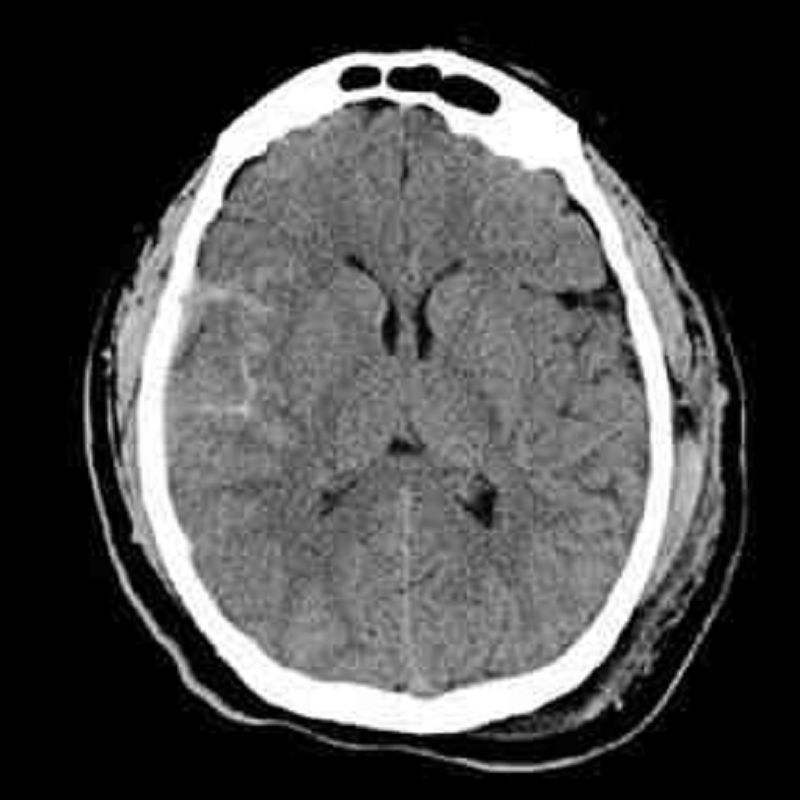
A 65-year-old male with a history of atrial fibrillation, congestive heart failure, and hypertension is brought in by ambulance after being found by his wife in the bathroom unconscious. She heard something fall and found him laying on the ground unresponsive. Initial vital signs demonstrate BP 224/121, P 76, RR 16, O2sat 94% room air. He is protecting his airway, but is disoriented and not following commands. An image from his noncontrast head CT is shown. Which of the following is the best medication for the management of his blood pressure?
Hydralazine
Nicardipine
Nimodipine
Nitroglycerin
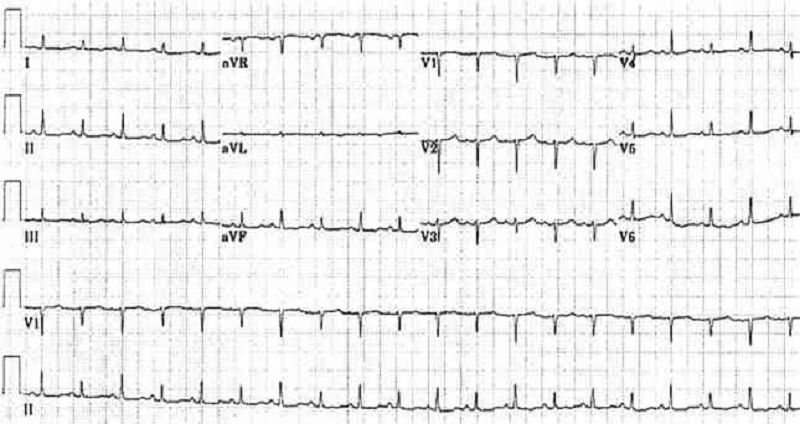
A 55-year old male with a history of recently diagnosed and untreated small cell lung cancer presents with acute on chronic shortness of breath for 1-2 hours. He is speaking 4-5 word sentences and is diaphoretic. BP 78/45, P 121, RR 29, T99.0F (37.2C), O2Sat 99% room air. Lung auscultation demonstrates minimal bibasilar crackles, and cardiac auscultation reveals muffled heart sounds. The patient demonstrates 6cm jugular venous distention. ECG is shown. Which of the following is the most appropriate initial step in management of this patient?
Dobutamine
Needle thoracostomy
Normal saline IV bolus
Rapid sequence intubation
A 65-year-old female presents to the emergency department with chest pain and shortness of breath. EKG reveals ST elevations in the anterior precordial leads V1 through V4. While waiting for transfer to the cardiac cath lab the patient develops worsening shortness of breath. Repeat EKG shows wide QRS complexes and a heart rate of 35. Blood pressure is 75/60. Atropine 0.5mg IV is administered without effect. What is the most appropriate next step in managing this patient?
Atropine 1mg IV
Cardioversion
Epinephrine 1mg IV
Electrical pacing
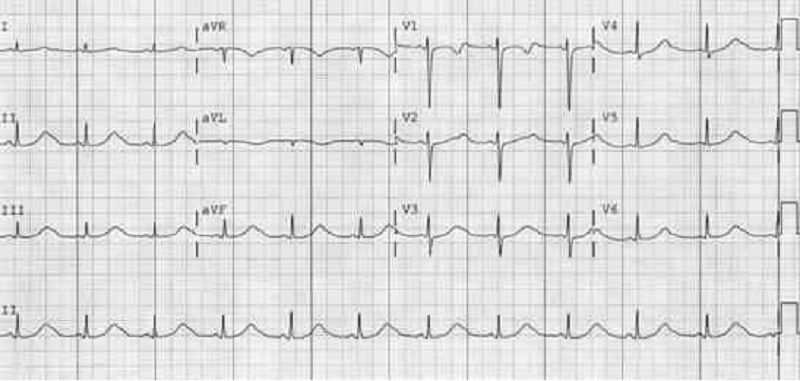
A 77-year-old female is brought in by ambulance for a syncopal episode today in the kitchen, witnessed by her daughter. Her past medical history includes hypertension and recently diagnosed pneumonia. She takes hydrochlorothiazide regularly and is almost finished with her levofloxacin. Vital signs are BP 131/78 mmHg, P 72 bpm, RR 16 bpm, O2sat 98% room air, T98.4F (36.9C). The patient reports feeling palpitations and lightheadedness immediately before losing consciousness. Currently, the patient denies chest pain, fever, shortness of breath, vomiting or abdominal pain. ECG is shown. What should be the next step in management of this patient?
Calcium gluconate
Magnesium sulfate
Sodium bicarbonate
Transvenous pacing
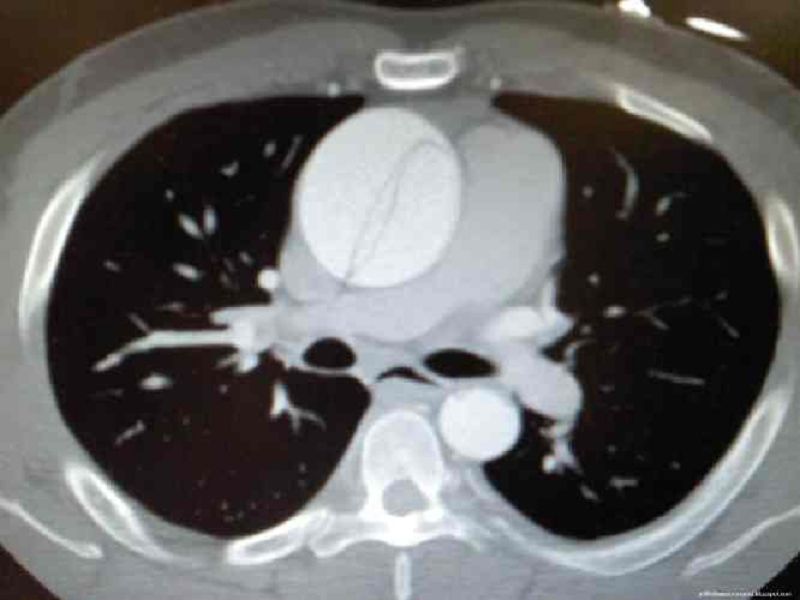
A 55-year-old female with hypertension presents with sudden onset tearing chest pain radiating to her upper back. Vital signs are: BP 151/89, P 99, RR 18, O2Sat 99% room air, T 98.5F (36.9C). Physical exam reveals diminished bilateral femoral pulses. An image of the computed tomography angiography of the chest is shown. Morphine has resolved her pain. Labetalol is ordered and pending. What is the next best step in the management of this patient?
Administer aspirin
Admission to the ICU
Emergent cardiology consultation for cath lab
Emergent CT surgery consultation
A 55-year-old male with a history of congestive heart failure presents to the emergency department with shortness of breath. Vital signs are: BP 220/150 mmHg, HR 110 bpm, RR 35 bpm, O2 Sat 89% on room air. Which of the following is the most appropriate initial agent for blood pressure reduction and improvement of respiratory status?
Labetolol
Nicardipine
Nitroglycerin
Nitroprusside
A 30-year-old male is brought in by ambulance 30 minutes after a brief episode of loss of consciousness. He was standing in line at the supermarket when he suddenly felt nausous, noted tunnel-vision, and then passed-out. Immediately prior to the event he felt diaphoretic, warm, and nauseated. He has no past medical history. He is now asymptomatic with normal vital signs and a normal physical examination. Electrocardiogram is within normal limits. What is the most likely cause of this patient’s syncopal episode?
Cardiac
Medication-induced
Pulmonary embolism
Vasovagal
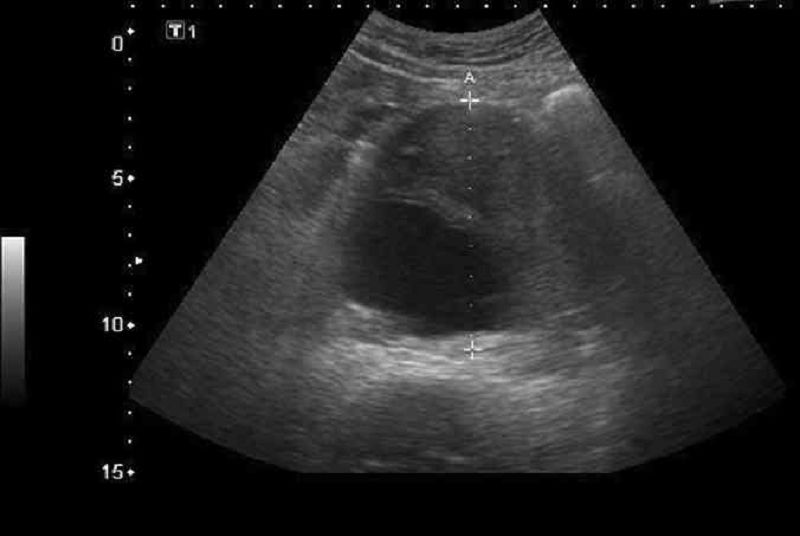
A 65-year-male is brought in by ambulance for severe abdominal pain causing near syncope. The pain began one hour ago in his abdomen and radiates to the flank. He has associated nausea, vomiting and lightheadedness. Past medical history is significant for hypercholesterolemia, hypertension and tobacco. Vital signs are: BP 89/65, P 97, RR 22, T99.0F (37.2C), O2Sat 100% room air. Your bedside ultrasound of the abdominal aorta is shown below. What is the next best step in the management of this patient?
CT abdomen
Formal abdominal ultrasound
Interventional radiology consult
Vascular surgery consult
A 4-year-old female is brought in to the emergency department after “passing out.” Her parents report that the child was upset because her toy broke and was crying, then turned blue and lost consciousness. She has a history of two prior similar events in the past while crying. On presentation the child is alert, oriented, and is jumping around the room playing with her sister. Complete physical exam, including a cardiac and neurologic exam, is unremarkable. ECG is normal. Which of the following is the correct next step in management?
Admission to a monitored bed for 24 hours telemetry
Discharge home
Echocardiogram and chest x-ray
Head CT
Which of the following is a characteristic of the most common type of abdominal aortic aneurysm?
Difficult to diagnose on ultrasound
Does not extend into the iliac vessels
Fusiform dilation of the abdominal aorta
Most common location is suprarenal
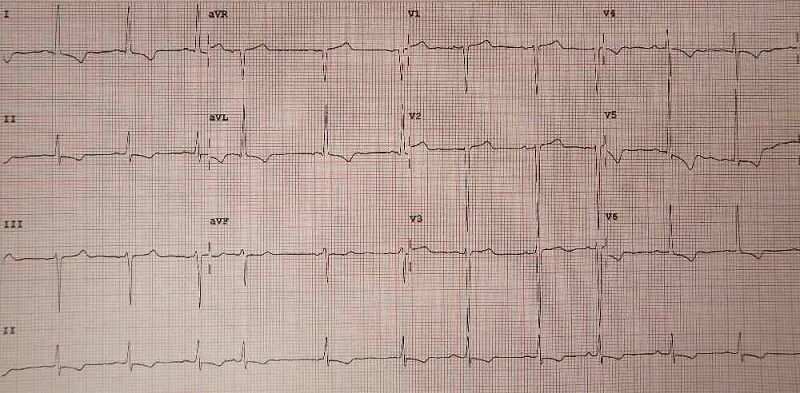
A 17-year-old male is brought to the ED after losing consciousness at football practice. He denies any preceding symptoms and has a normal physical examination. An ECG is obtained as shown. Based on these findings, which of the following is the most likely diagnosis?
Brugada Syndrome
Hypertrophic Cardiomyopathy
QT prolongation
Wolff-Parkinson-White Syndrome
A 70-year-old male presents to a trauma level 1 emergency department with 1 hour of crushing left sided chest pain. EKG reveals a STEMI. Vital signs BP 180/110 HR 90 RR 12 O2sat 100%. Past medical history is significant for history of ischemic stroke nine months previously. Which of the following is the best intervention for this patient?
Aspirin alone
Aspirin and thrombolytics
Aspirin and PCI
IV antihypertensive medications, then thrombolytics
A 68 year old male with hypertension, diabetes, a history of smoking and a history of kidney stones presents with acute onset severe left flank pain for the past two hours. His vital signs are BP 89/48, HR 125, RR 22, 98%, T98.6F (37C). Which of the following would be the most important immediate diagnostic test at this time?
Bedside ultrasound
CT stone protocol for obstruction
Lactate and blood cultures
Urine dipstick
A 35-year-old female presents with 1 week of flu-like symptoms as well as chest pain which is worse with lying flat and improved by leaning forward. Vital signs are: BP 130/80, HR 120, RR 20, T 101F (38.3 C). Physical exam reveals an uncomfortable appearing female but is otherwise unremarkable. ECG shows sinus tachycardia, and laboratory analysis is significant for an elevated troponin. What is the most likely diagnosis?
Chagas Disease
Myocarditis
Pericarditis
STEMI
A 63-year-old female presents with severe pain and bluish discoloration of her left toes. Past medical history is concerning for hypercholesterolemia and a 10 pack-year smoking history. Physical exam reveals a blood pressure of 170/100 mmHg, blue digits on the left lower extremity, non-palpable dorsalis pedis and posterior tibialis pulses on the left, and 2+ pulses on the right lower extremity. Aortic ultrasound is unremarkable and other than lower extremity pain, the patient has no complaints. What is the best initial treatment for this condition?
Embolectomy
Heparin
Nitroprusside
Warfarin
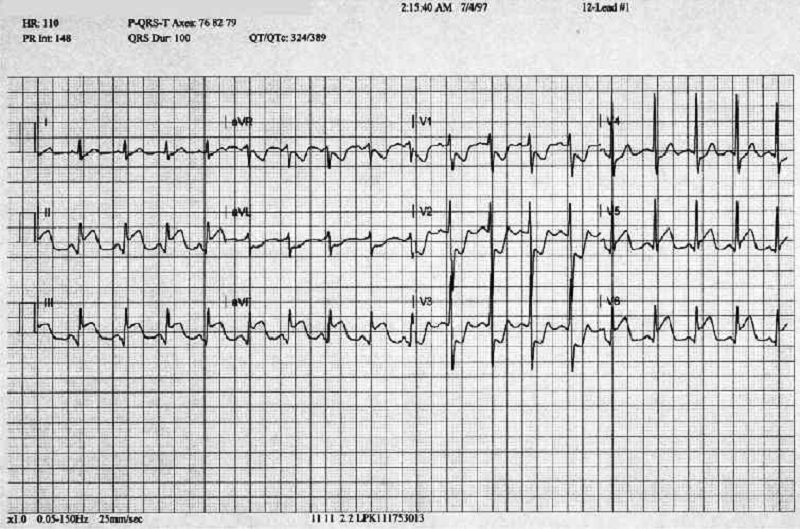
A 45-year old male presents to the Emergency Department with acute onset chest pain and shortness of breath less than 1 hour ago while mowing his lawn. Initial EKG is shown below. Which coronary artery is most likely to be occluded?
Left anterior descending
Left circumflex artery
Right coronary artery
Sinoatrial artery
A 72-year-old male with type 2 diabetes, hypertension, and a history of aortic stenosis requiring valve replacement one month prior presents to the emergency department with fever and fatigue of 3 days’ duration. Vital signs are: BP 145/87 mmHg, P 107 bpm, RR 20 bpm, O2 Sat 94%, and T101.4F (38.2C). Physical examination is remarkable for a 3/6 decrescendo diastolic murmur at the right upper sternal border and faint crackles present at both lung bases. Which of the following is the most likely causative organism?
Aspergillus
Strep pneumoniae
Staph aureus
Strep viridans
A 55-year-old female with no past medical history presents to the emergency department for a swollen and painful left calf. She receives a diagnosis of partial deep vein thrombosis of the left popliteal vein. Vital signs, chest radiography, and electrocardiogram are within normal limits. Your hospital has a protocol for outpatient treatment of isolated DVTs and this patient wishes to leave. Which of the following treatment measures should be initiated?
Aspiring
Edoxaban
LMWH and warfarin
Warfarin alone
A 10-year-old boy with no significant past medical history is brought into the emergency department because his “chest feels funny.” He otherwise has no complaints. Vital signs are as follows: T 37C (98.6F) HR 177 BP 105/60 RR 18 SPO2 100%. Physical exam is significant for a well-appearing child with tachycardia. The remainder of the exam is unremarkable. An EKG is performed and shows a narrow complex regular tachycardia without P waves. What is the best next step in management?
Adenosine
Atropine
Synchronized cardioversion
Vagal maneuevers
A 55-year-old female with no past medical history presents after loss of consciousness while exercising. She regularly runs 20 miles per week and experienced no symptoms prior to the episode. She has no history of a prior syncopal episode and there is no family history of sudden cardiac death. Vital signs are: BP 88/52 mmHg, HR 82 bpm, RR 14 bpm, Sp02 99% on room air, T 98.8F (37.2C). What is the most appropriate disposition for this patient?
Admission to monitored bed
Admission to ward bed
Discharge home with PCP follow up
Discharge home with cardiology
{"name":"Cardiovascular EM Quiz", "url":"https://www.quiz-maker.com/QPREVIEW","txt":"Test your knowledge on critical cardiovascular emergency scenarios with this engaging quiz. Designed for healthcare professionals, this quiz encompasses a range of topics related to cardiac care in emergency settings.20 Multiple Choice QuestionsFocus on real-life emergency casesImprove your clinical decision-making skills","img":"https:/images/course4.png"}
More Quizzes
Shock and Shock Management
10528
Sepsis
10522
new Part 4 (765-865) (765-1019) NR 3
100500
IM med
1780
Part 37
65320
Approach to a patient with Chest pain in ED
12620
GCS score
6332
New part5(1132-1172) nana 4
100500
Paediatric Trauma Imaging
5218
QCU/DES/USMLE/CADIOVASCULAIRE 200-345
145720
(NEW) DES 2016-2017 : 2040-2299 (Fabien) 5
100500
ENDO - INTERNAL 2021
502527